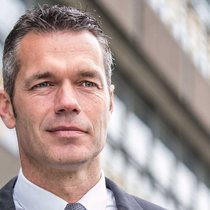According to the most recent population forecast, the city of Amsterdam will have more than 1 million inhabitants in 2040 and tourism is expected to grow from 18 million people per year in 2018 to 23 million people per year in 2023. Inevitably, issues such as congestion, the misalignment of the supply and demand for public transport and air pollution are placing growing pressure on the city.
Given these competing demands for the use of public space, Amsterdam is urgently seeking innovative solutions for sustainable, reliable and inclusive mobility. The overall goal is to keep the city liveable and accessible and its citizens healthy and mobile.
Celebrating the 5-year anniversary of AMS Institute, we are launching a series of long-reads. In attempt to untangle the urban challenges, celebrate successes, collaborations, steps forward, solutions we worked on and the impact we've created over the past 5 years - together with our partners.
Exploring the feasibility of new mobility concepts
To support the City of Amsterdam in this search for mobility solutions, AMS Institute works on a Smart Urban Mobility program. In this article we will elaborate on how we work on the different domains of the challenge: (1) Infrastructure, (2) Data, (3) New Modes of Transport, (4) Travelers' Experience, and (5) Automated vehicles.
Overall the program explores the feasibility of concepts such as shared mobility, Mobility as a Service (MaaS), new infrastructures, ‘autonomous’ vehicles – think of cars, drones and boats - and their impact on urban design and the city. Furthermore, within the projects in the program, data is collected from different sources. Real-time traffic data and analytics can be used in the process of (re)designing public space and making better use of existing infrastructure.
1. INFRASTRUCTURE
The impact of infrastructural changes on a city
Smooth transportation in a city is inevitably linked with the infrastructures that underlie the modes of transport. Think of the roads, tram and metro lines, and stations that are needed to get you from A to B on a daily basis. With the city of Amsterdam expanding, and the number of visitors growing, the infrastructure of the city is increasingly under pressure.
One of the essential elements in the mobility network of Amsterdam is the metro infrastructure. With its five lines and a total length of 52.2 kilometers, it transports 1,400,000 passengers per week. In 2018 it was extended with a new line, the Noord/Zuidlijn, which is expected to move 121.000 passengers daily by 2030. Such a massive infrastructure project has a significant impact on accessibility, urban development, economy, and public space and thereby presents a large-scale solution and research opportunity.
This is why AMS Institute participated in the research project Impact Analysis of the Noord/Zuidlijn, which is set out to cover 4 research areas: Public Transport, Mobility & Accessibility, Area Development & Public Space and Spatial Economy. Some of the research questions are how the Noord/Zuidlijn affects the service of Amsterdam’s public transport, what is the impact on the entire transport system in the region of Amsterdam, how public space near metro stations changes and how spaces nearby the metro stops develop.
“It is great that we have the opportunity to investigate the wider impacts of this big infrastructure investment and network changes. The results will help to optimize the current system, but also support future assessments of infrastructure investments since we learn more about the wider costs and benefits.”
Niels van Oort
Associate Professor & co-director of the Smart Public Transport Lab
This helps us to understand how the Amsterdam public transport network has changed due to the Noord/Zuidlijn and how passengers perceive their new travel times.
Stations as a gateway to the city
As cities worldwide continue to grow, mobility hubs, like stations are - more than ever - the main point of intersection between the rail network and the city. Besides that, they are the central link in the mobility chain and a key element in the organization of intermodal transport. Passenger growth, climate change, energy transition and new mobility developments, such as Mobility as a Service, are just a few of the challenges future stations have to cope with. However, they are also expected to be energy-efficient and environmental-friendly.
AMS Institute’s research project Stations of the Future is part of the Smart Urban Mobility program. It investigates integrated mobility approaches and new design challenges of rail-metro stations of two rapidly growing developing metropolitan areas in The Netherlands and France: the Randstad and Métropole du Grand Paris.
“We need to think about what the station means to the city now and in the future and its connection to other modalities of transport, be it metro, bus, pedestrian walkways or on-demand services.”
Manuela Triggianese
Research Fellow
Starting with the Randstad as living laboratory, ‘Stations of the Future’ explores integrated metropolitan challenges by linking the transversal discipline of infrastructural planning, urban design, architecture, and urban management among others.
2. DATA
Analyzing and predicting behavioral patterns
An example of a Smart Urban Mobility project that works on collecting data is the ‘Urban Mobility Observatory’ (UMO). Through an extensive system of sensors and ICT infrastructure and various methods of data collection, it observes mobility and travel behavior for research on mobility and transport in urbanized regions. By using and combining this data, better decisions can be made to create safe and efficient experiences for both citizens and visitors.
In Amsterdam, there are many modes of transport competing for the same square meters. Think of pedestrians, bikes, cars, trams, buses, delivery vans, and so on. Some of these transport flows are quite predictable, such as public transport. However, it has always been a challenge to understand the behavior of pedestrians and cyclists in traffic and transportation. Therefore, AMS Institute has been involved in the ‘ALLEGRO’ project for the past 5 years. This project researches the active modes in the city of Amsterdam, such as walking and cycling. The complex behavioral dimensions and interactions between pedestrians and cyclists require a deep understanding of human behavior, advanced modeling techniques, and collective behavior.
“Until now, ALLEGRO has resulted in many novel insights into pedestrian and cyclist behavior as well as methods to observe and model this behavior. For instance, we have a much better understanding of what drives people to walk or use their bike, which allows more targeted policy design to increase the share of active mode users.”
Serge Hoogendoorn
Professor & AMS PI
Within the ALLEGRO project, similar insights were also achieved in the route choice behavior of cyclists, allowing us to predict the impact of interventions, such as fewer stops at intersections, on the attractiveness of a route. Analyzing the behavior of tourists has revealed which activities different groups of tourists are involved in, and where these activities are performed.
3. NEW MODES OF (PUBLIC) TRANSPORT
The rise of Mobility as a Service: seamless door-to-door transport
Nowadays, there is also a broad range of different transport services which go beyond traditional public transport by bus, train, metro, and tram. New options include personalized and self-organized solutions such as ride-sharing, ride-hailing (e.g. Uber) and new concepts such as Mobility as a Service (MaaS). These new mobility solutions reflect changes in the economy and in the way urban life is organized. They must offer more flexibility, efficiency and an on-demand approach, which means they have to be smart and responsive to the traveler’s needs. At the same time, shared values and inclusiveness are essential elements in this development, as everyone needs to be able to make use of the services: think of the elderly, people on a small budget, or those who are less digitally skilled.
Mobility as a Service (MaaS) is currently one of the most relevant concepts for supporting seamless door-to-door transport. The term MaaS covers a wide range of on-demand and flexible services, including ride-sharing, ride-sourcing, e-hailing, all arranged in one app. The key concept behind MaaS is to offer travelers mobility solutions based on their travel needs. Different modes of transportation are combined to optimize traveling, and for this to work, the switch from one mode to another must be pleasant in the physical realm and seamless in the virtual realm. Instead of owning a vehicle or buying single tickets for a different kind of transport, people buy a monthly subscription for multi-user ride-sourcing services.
Predict the performance of on-demand transport services in Amsterdam
MaaS is expected to decrease costs to the user, improve utilization of MaaS transit providers, reduce city congestion and, as a consequence, emissions. Moreover, with the anticipated arrival of fully-automated vehicles, MaaS can become more and more applicable at large scale. These vehicles could have an impact on the quality of life in urban areas and form a critical part of the future of transportation. Besides that, it can benefit the traveler, the environment, and even other sectors such as health. On the opposite side, we still don’t know the significant scale effects of MaaS and what it means for cities and its citizens.
AMS Institute’s research program CriticalMaaS develops and tests theories and models to explain and predict the performance of flexible on-demand transport services offered by Mobility as a Service provider in Amsterdam.
“Using behavioral and business models, we study individual consumers’ and suppliers’ preferences and dynamics. These models will be integrated into a network simulation of Amsterdam and study the supply-demand interactions within the MaaS context and under alternative policy regulations. We will then examine how MaaS performs under different circumstances and their consequences for urban mobility.”
Key research questions include: What is the potential market share of MaaS under different conditions? How large does a fleet need to be when introducing a new on-demand service? How will such new services co-exist with conventional public transport? Will they compete or complement each other? How should conventional public transport evolve in response? How can MaaS services be best accommodated and steered to meet societal goals related to accessibility and equity? Cats: “In CriticalMaaS, we will study the conditions under which MaaS and related developments in shared mobility can create a virtuous cycle with a special focus on system-wide accessibility, efficiency and equity effects.
Responsive and intelligent public transport systems
To increase the efficiency and service of future public transport systems, AMS Institute is involved in 'Smart Cities Responsive Intelligent Public Transport Systems' (SCRIPTS). This research program assesses the expected impacts when traditional fixed and future flexible public transport systems co-exist. The focus is both on the supply (optimal fleet size) and the demand side (passenger preferences). The mobility landscape is changing rapidly. Think of on-demand services becoming available.
“We want to find out how on-demand public transport systems could improve our total mobility and cities, so we need to understand how it works and who will use it. We found out that for instance, 47% of our population is open to use on-demand systems, while 28% is not willing to use these new modes at all. Our simulations show that one on-demand vehicle could replace nine private cars in Amsterdam.”
Niels van Oort
Associate Professor & co-director of the Smart Public Transport Lab
The research aims to make public transport more efficient and more attractive to all kinds of users. It can reduce the use of private vehicles, which in its turn helps to diminish congestion on roads and adverse environmental impacts such as pollution. Furthermore, the research could enable the inclusion of users who are not served by the conventional public transport system, such as low demand areas and can act as a testbed for policymakers and planners. They can investigate the various innovative on-demand services and the implications of their integration with conventional public transport systems.
4. TRAVELERS' EXPERIENCE
Integrated travel solutions through a smartphone application
With all these new mobility services, it is quite surprising that travelers still have limited access to integrated door-to-door information on a given journey, when they want to get from A to B. To improve the travel experience, AMS Institute works on 'My-TRAC' (My Travel Companion). This project researches and develops a smartphone application that functions as a travel companion. It connects information from rail operators, mobility-as-a-service and other public transport providers and analyses data with innovative algorithms that recommend best travel solutions, specifically for first and last-mile travel in Amsterdam.
My-TRAC’s is the first full-scale integration of public transport data that allows for multi-scale, multi-modal and analytical tooling. How? By using a human-machine interface and various functionalities like crowdsourcing, group recommendations, and data exchange, it fosters the involvement of users before, during and after a trip.
“The key is that the My-TRAC app learns to predict how individual public transport users make choices.”
My-TRAC helps travelers to developing greater confidence in, and adhesion to, multimodal transport services.
5. AUTOMATED VEHICLES
The impact of automated driving
Next to the already existing new mobility services that have an impact on the system, there’s also a potentially huge change in mobility with the arrival of automated driving. A complex system performs the act of driving by use of electronics and machinery instead of a human driver, and thereby reduces the responsibility and involvement of the driver. To enable better decision-making for investments and planning for the future of automated driving, AMS Institute participates in the 'Spatial and Transport Impacts of Automated Driving' (STAD) project. This joint research project investigates the impact of automated driving on accessibility, mobility and spatial development.
Not only are we looking at the potential impact this innovation has on the city, with the 'Meaningful Human Control over Automated Driving Systems' (MHC) project, AMS Institute tries to help research innovation in self-driving cars in a responsible way. It’s necessary to have a definition of what meaningful human control over self-driving cars exactly is, as it has been identified as key for the design of autonomous systems. The main research questions are: who is responsible in case of an accident? Who must have knowledge of the software? Furthermore, the project develops methodologies, policies, and regulations to promote innovation in self-driving cars.
“On a philosophical level, the theory of Meaningful Human Control (MHC) has been further developed regarding the conditions of tracking and tracing to help identify responsibility gaps. The project has been applied to traffic to demonstrate that current systems insufficiently consider human behavior and capabilities and therefore leave control gaps. Efforts are on-going to operationalize MHC to allow the concept to be applied for automated vehicle design and evaluation.”
Getting ready for autonomous driving
In 2020 we will be putting autonomous driving into practice. Together with the Municipality, Local Motors, Transport Authority Amsterdam and GVB, we will run a 3-month pilot with Olli, an autonomous vehicle, at Marineterrein. The main goal is to learn and gain operational and practical experience. By running this pilot, it is aimed to test whether autonomous vehicles can be implemented in other city districts and what further research should be done. Does autonomous transportation, for example, offer a solution for congestion? Can a self-driving car deliver packages?
“In order to successfully implement autonomous vehicles in the city, it's important to investigate the interactions with all aspects of the urban environment - from citizens to infrastructure.”
Tom Kuipers
Program Developer
Include Amsterdam waterways in mobility solutions
While the prototypes of self-driving cars are taking the road, the 200 kilometers of canals in Amsterdam offer opportunities for transport too. Just like in the past, it’s logical for the city to include these waterways in the search for smart, sustainable and seamless mobility solutions.
One of AMS Institute’s most eye-catching projects makes use of these waterways. Roboat is a self-driving boat that can be used for various applications: from carrying goods and people, to waste collection and inspecting quay walls or bridges. All kinds of structures can be built by lining up the boats, like a temporary footbridge or a floating stage. During its journey, the boat autonomously responds to its surroundings, and it can measure water quality and other (environmental) aspects.
6. COLLABORATIONS & RESEARCH FOCUS AHEAD
Mobility challenges stretch beyond Amsterdam and The Netherlands
The transition to sustainable, reliable and inclusive mobility is not only a technical challenge. It brings social and societal challenges too, which go beyond Amsterdam and The Netherlands. The demand for shared and clean transport solutions and on-demand transport in urban areas is also growing rapidly in the rest of Europe. Also, many European cities are setting ambitious climate targets to meet the goals of the Paris Agreement. This trend continues as urbanization in Europe is expected to increase to 83% by 2050.
To strengthen, shape and implement innovation capacity in Europe - and thus also the Netherlands and Amsterdam - in the field of urban mobility, AMS Institute is a member of EIT Urban Mobility. This winning consortium will be developing a European innovation program on the topic of urban mobility. By being a member of the consortium, together with the city of Amsterdam, AMS Institute will be able to participate in projects financed by the EIT Urban Mobility. These projects can include collaborations in living labs, in which science, government and business work together on new mobility solutions.
Provide innovative and new solutions for urban mobility
Tom Kuipers is Program Developer of Smart Urban Mobility. He explains why being part of EIT Urban Mobility is of great importance for Amsterdam’s position as an accessible and liveable city. “EIT Urban Mobility provides us with a broad European network of cities, universities, research institutes, and businesses that are all aiming to be leading in the field of urban mobility and to provide innovative and new solutions for urban mobility. Working together, we can achieve great results in improving our cities.”
Potential for new management of mobility in the city
In the near future, AMS Institute has more innovative projects lined up. In cooperation with the municipality of Amsterdam, the institute has the plan to set up a physical mobility test center in our office. At this ‘Innovation Centre for Digital Mobility management’, regional mobility data will be collected, monitored and used for research and applications. This way, mobility flows can be flexibly managed, which benefits a liveable and accessible city with healthy and mobile citizens.
“The innovation center is unique as it allows us to test and pilot with new and innovative combinations of city data and data from public and private partners”
Tom Kuipers
Program Developer
Combining data from connected vehicles, mobility platforms and the assets of the city of Amsterdam can help to get more insight, a better understanding and potential for new management of mobility in the city.
With the Smart Urban Mobility Program, AMS Institute aims to help create a future where mobility in Amsterdam is flexible, clean, affordable and available for everyone.
We do not know what the future of mobility will look like, but by researching, testing, piloting and implementing new solutions, together with stakeholders, we can find out in which direction we want to go. Mobility is not a goal in itself, but a means to connect people and get them from A to B. In the end, we are all working on creating liveable urban environments, where people like to be.




